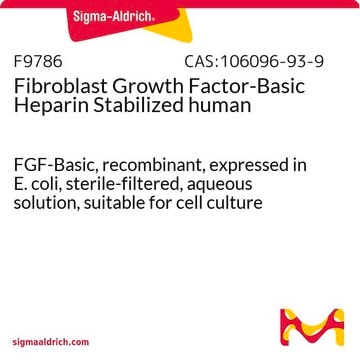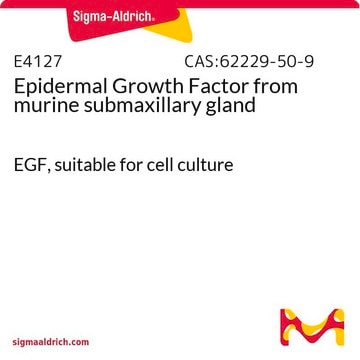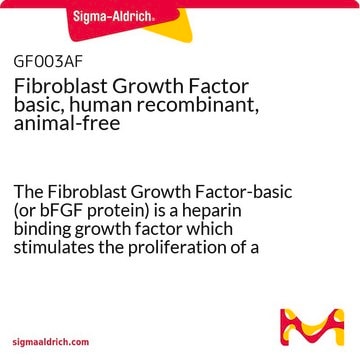F5542
Fibroblast Growth Factor-Acidic human
FGF-Acidic, recombinant, expressed in E. coli, suitable for cell culture
Synonyme(s) :
FGF-1, aFGF
About This Item
Produits recommandés
Source biologique
human
Niveau de qualité
Produit recombinant
expressed in E. coli
Pureté
≥97% (SDS-PAGE)
Forme
lyophilized powder
Puissance
0.287 ng/mL
Qualité
endotoxin tested
Poids mol.
15.5 kDa
Conditionnement
pkg of 25 μg
Conditions de stockage
avoid repeated freeze/thaw cycles
Technique(s)
cell culture | mammalian: suitable
Impuretés
≤1.0 EU/mg (LAL test)
Numéro d'accès UniProt
Température de stockage
−20°C
Informations sur le gène
human ... FGF1(2246)
Catégories apparentées
Description générale
Application
- as a component of growth factor cocktail for treating neural stem cell (NSC) transplants
- as a component of Human Neural Stem Cell (HNSC) proliferation medium for Neural Tissue Spheres (NTS) propagation
- as a growth factor component in fibrin matrix to support embryonic day 14 (E14) cells graft survival
Actions biochimiques/physiologiques
Forme physique
Remarque sur l'analyse
Code de la classe de stockage
11 - Combustible Solids
Classe de danger pour l'eau (WGK)
WGK 3
Point d'éclair (°F)
Not applicable
Point d'éclair (°C)
Not applicable
Équipement de protection individuelle
Eyeshields, Gloves, type N95 (US)
Certificats d'analyse (COA)
Recherchez un Certificats d'analyse (COA) en saisissant le numéro de lot du produit. Les numéros de lot figurent sur l'étiquette du produit après les mots "Lot" ou "Batch".
Déjà en possession de ce produit ?
Retrouvez la documentation relative aux produits que vous avez récemment achetés dans la Bibliothèque de documents.
Les clients ont également consulté
Articles
Fibroblast growth factors in cell culture and various growth factors for your research
Role of growth factors in stem cell differentiation and various growth factors for your research at sigmaaldrich.com
Notre équipe de scientifiques dispose d'une expérience dans tous les secteurs de la recherche, notamment en sciences de la vie, science des matériaux, synthèse chimique, chromatographie, analyse et dans de nombreux autres domaines..
Contacter notre Service technique













